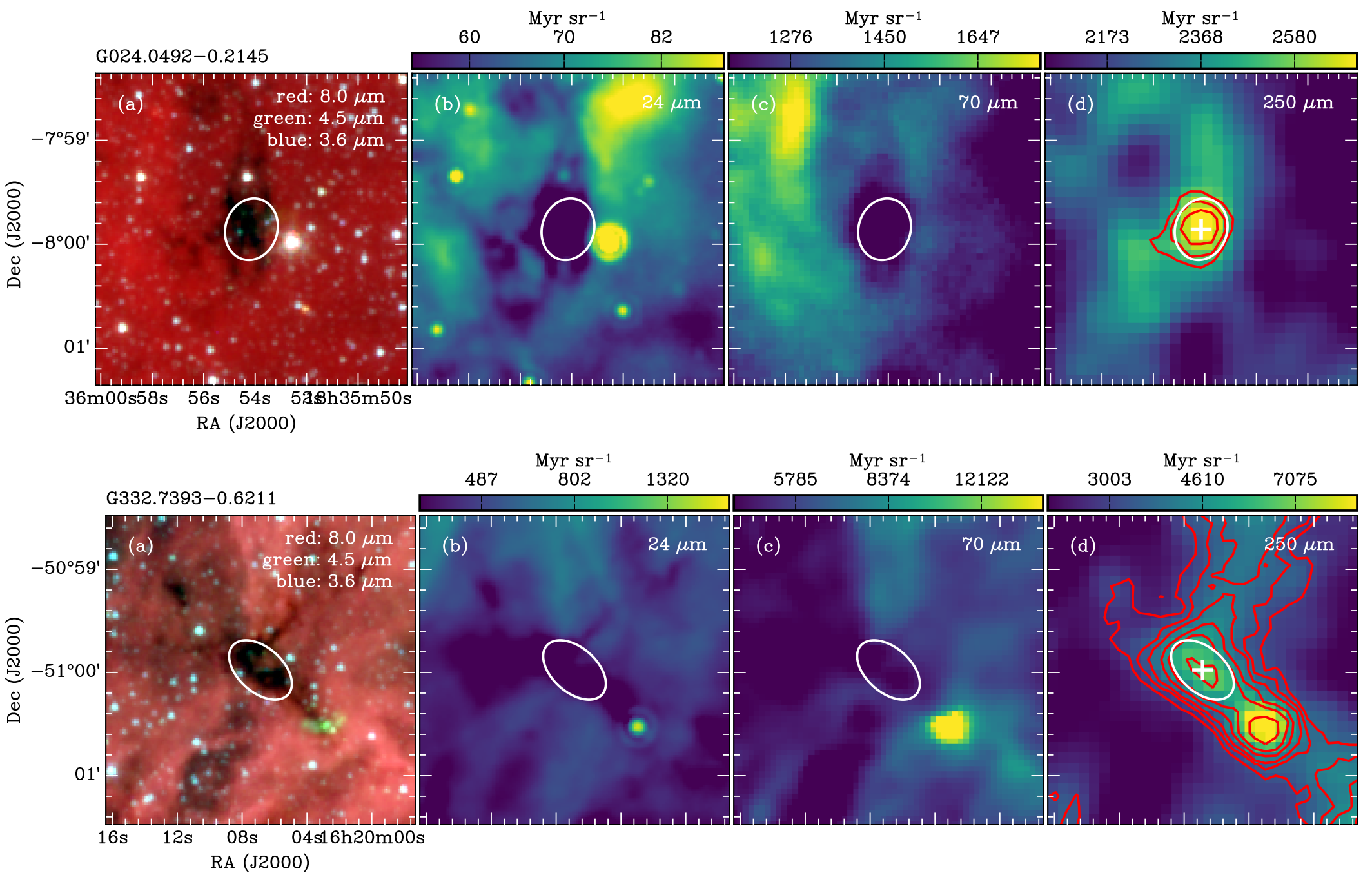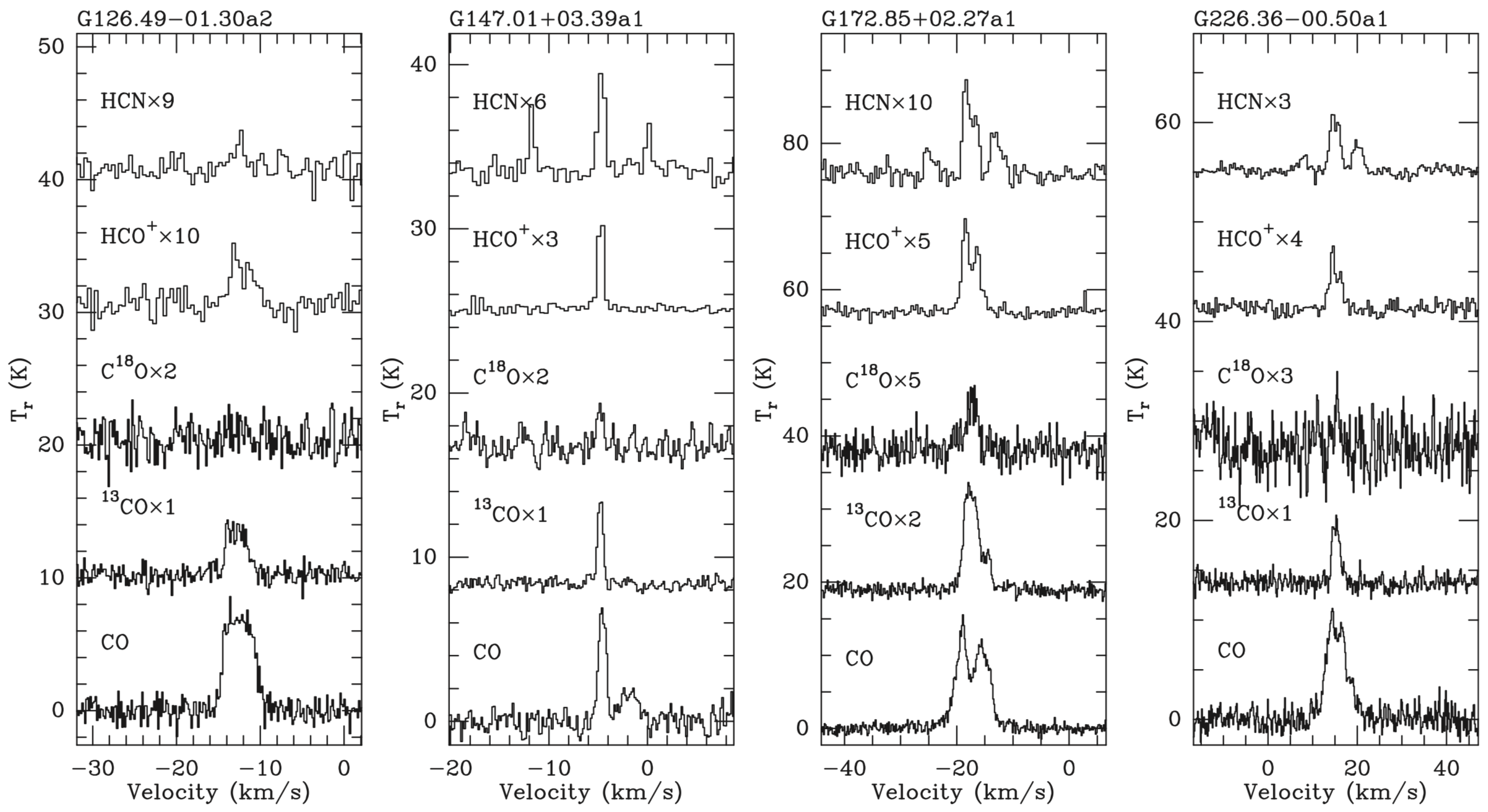5. Filamentary Flows and Clump-fed HMSF in G22
How mass is accumulated from cloud-scale down to individual stars is a key open question in understanding high-mass star formation. Here, we present the mass accumulation process in a hub-filament cloud G22 which is composed of four supercritical filaments. Velocity gradients detected along three filaments indicate that they are collapsing with a total mass infall rate of about 440 Msun/Myr, suggesting the hub mass would be doubled in six free-fall times, adding up to ~2 Myr. A fraction of the masses in the central clumps C1 and C2 can be accounted for through large-scale filamentary collapse. Ubiquitous blue profiles in HCO+ (3-2) and 13CO (3-2) spectra suggest a clump-scale collapse scenario in the most massive and densest clump C1. The estimated infall velocity and mass infall rate are 0.31 km/s and 7.2×10^-4 Msun/yr, respectively. In clump C1, a hot molecular core (SMA1) is revealed by the SMA observations and an outflow-driving high-mass protostar is located at the center of SMA1. The mass of the protostar is estimated to be 11-15 Msun and it is still growing with an accretion rate of 7×10^-5 Msun yr. The coexistent infall in filaments, clump C1, and the central hot core in G22 suggests that pre-assembled mass reservoirs (i.e., high-mass starless cores) may not be required to form high-mass stars. In the course of high-mass star formation, the central protostar, the core, and the clump can simultaneously grow in mass via core-fed/disk accretion, clump-fed accretion, and filamentary/cloud collapse.


4. High-mass starless clumps in the inner Galactic Plane
From 10861 ATLASGAL clump, we identified 463 high-mass starless clump (HMSC) candidates with −60 < l < 60 degree and −1 < b < 1 degree. All of these sources have been queried in SIMBAD to make sure they are not associated with any known star-forming indicator. Young stellar objects were identified from the GLIMPSE catalog using color-based criteria and the associated clumps were excluded. We also make sure that the HMSC candidates have neither point sources at 24 and 70 µm nor strong extended emission at 24 µm. Most of the identified HMSCs are infrared dark and some are even dark at 70 µm. Their distribution shows crowding in Galactic spiral arms and toward the Galactic center and some well known star-forming complexes, and some HMSCs are associated with large-scale filaments. Some basic parameters were attained from column density and dust temperature maps which were constructed via fitting far-infrared and submillimeter continuum data to modified blackbodies. The HMSC candidates have sizes, masses, and densities similar to clumps associated with Class II methanol masers and H ii regions, suggesting that these starless clumps will evolve into star-forming clumps. More than 90% of the HMSC candidates have densities above some proposed thresholds for forming high-mass stars. The HMSC candidates have dust temperatures and luminosity-to-mass ratios significantly lower than star-forming sources, suggesting they are genuinely at very early stages of high-mass star formation. Seventeen sources with equivalent radii < 0.15 pc and (Σ > 0.08 g cm^2) could be possible high-mass starless cores. Further investigations toward these HMSCs would undoubtedly shed light on comprehensively understanding the birth of high-mass stars.

3. Dense gas in molecular cores associated with Planck Galactic cold clumps
We have carried out the first survey of dense gas toward Planck Galactic Cold Clumps (PGCCs). Observations in the J = 1–0 transitions of HCO+ and HCN toward 621 molecular cores associated with PGCCs were performed using the Purple Mountain Observatory’s 13.7 m telescope. Among them, 250 sources were detected, including 230 cores detected in HCO+ and 158 in HCN. Spectra of the J = 1–0 transitions from 12CO, 13CO, and C18O at the centers of the 250 cores were extracted from previous mapping observations to construct a multi-line data set. The significantly low detection rate of asymmetric double-peaked profiles, together with the good consistency among central velocities of CO, HCO + , and HCN spectra, suggests that the CO-selected Planck cores are more quiescent than classical star-forming regions. The small difference between line widths of C18O and HCN indicates that the inner regions of CO-selected Planck cores are no more turbulent than the exterior. The velocity-integrated intensities and abundances of HCO+ are positively correlated with those of HCN, suggesting that these two species are well coupled and chemically connected. The detected abundances of both HCO+ and HCN are significantly lower than values in other low- to high-mass star-forming regions. The low abundances may be due to beam dilution. On the basis of an inspection of the parameters given in the PGCC catalog, we suggest that there may be about 1000 PGCC objects that have a sufficient reservoir of dense gas to form stars.

2. Expanding shell and star formation in the infrared dust bubble N6
We have carried out a multiwavelength study of the infrared dust bubble N6 to extensively investigate the molecular environs and star-forming activities therein. Mapping observations in 12CO J = 1–0 and 13CO J = 1–0 performed with the Purple Mountain Observatory 13.7 m telescope have revealed four velocity components. Comparison between distributions of each component and the infrared emission suggests that three components are correlated with N6. There are 10 molecular clumps detected. Among them, five have reliable detections in both 12 CO and 13CO and have similar LTE and non-LTE masses ranging from 200 to higher than 5000 Msun. With larger gas masses than virial masses, these five clumps are gravitationally unstable and have the potential to collapse to form new stars. The other five clumps are only reliably detected in 12 CO and have relatively small masses. Five clumps are located on the border of the ring structure, and four of them are elongated along the shell. This is well in agreement with the collect-and-collapse scenario. The detected velocity gradient reveals that the ring structure is still under expansion owing to stellar winds from the exciting star(s). Furthermore, 99 young stellar objects (YSOs) have been identified based on their infrared colors. A group of YSOs reside inside the ring, indicating active star formation in N6. Although no confirmative features of triggered star formation are detected, the bubble and the enclosed H ii region have profoundly reconstructed the natal cloud and altered the dynamics therein.

1. The discovery of an infrared bipolar outflow
On the basis of GLIMPSE data we discovered a proto-stellar system driving a bipolar outflow. The bipolar outflow closely resembles the shape of an hourglass in the infrared. The total luminosity 5507 Lsun, derived from IRAS fluxes, indicates the ongoing formation of a massive star in this region. The spectral energy distribution (SED) of the driving source is fitted with an online SED fitting tool, which results in a spectral index of about 1.2. This, along with the presence of a bipolar outflow, suggests the detection of a Class I protostar. The driving source indicates prominent infrared excesses in color-color diagrams based on archived 2 MASS and GLIMPSE data, which is in line with an early evolutionary stage of the system.
